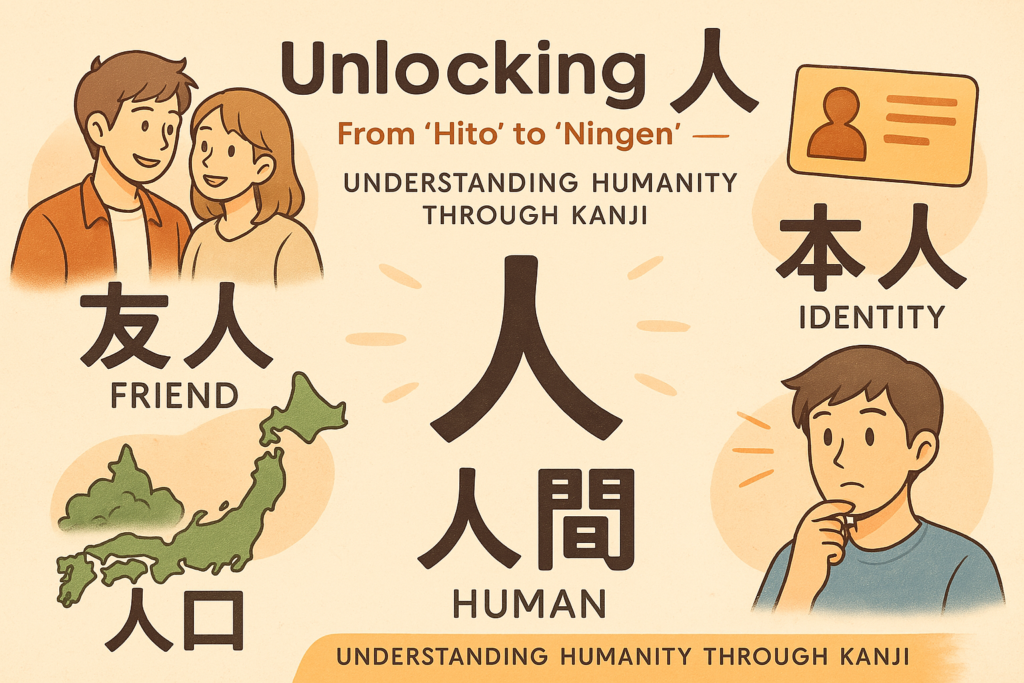Have you ever wondered how a single character can capture the essence of humanity? The person kanji (人) is one of the first symbols Japanese learners encounter, yet it carries profound meaning that extends far beyond its simple two-stroke appearance. This fundamental character not only represents individuals but serves as a building block for hundreds of other kanji related to human activities, relationships, and society.
The Meaning and Significance of Person Kanji (人)
The Japanese kanji for “person” or “human being” is written as 人 and pronounced as “hito” in its Japanese reading (kunyomi) or “jin/nin” in its Chinese reading (onyomi). This character is taught in the first grade of Japanese schools and is part of the JLPT N5 syllabus, making it essential for beginning Japanese learners.
What makes 人 particularly fascinating is how its visual form directly connects to its meaning. Unlike many abstract kanji, the person kanji visually represents what it symbolizes—a human figure in motion.
Origin and Evolution of Person Kanji
The 人 kanji has a rich historical background that makes it easier to understand and remember. In ancient Chinese pictographs, the earliest forms of this character resembled a side view of a standing person with a head, body, and legs.
Over centuries, this pictograph gradually simplified into the modern two-stroke character we recognize today. The evolution followed practical needs for faster writing while maintaining the essential visual concept of a human figure.
How to Write Person Kanji: Stroke Order
The proper stroke order for writing 人 is simple yet important:
- First stroke: Draw a diagonal line from top left to bottom middle
- Second stroke: Draw another diagonal line from top right to bottom middle
This stroke order creates a character that resembles a person walking or standing with legs spread slightly apart. Mastering this basic stroke pattern is crucial as it appears in many compound kanji characters.
Remembering Person Kanji Through Visualization
The simplest way to remember 人 is to visualize it as representing a person’s legs. As humans are the primary bipedal mammals in the world, the two diagonal strokes that form the character symbolize our unique way of standing and walking.
This mnemonic technique makes the kanji instantly recognizable and meaningful—whenever you see 人, think of a person walking forward on two legs.
Person Kanji as a Radical: Ninben (亻)
When 人 appears as a component in other kanji, it often takes a modified form called “ninben” (亻), which appears on the left side of characters. This radical indicates that the kanji has a meaning related to people or human activities.
For example:
- 休 (kyū) – “rest”: Shows a person (亻) leaning against a tree (木), suggesting someone resting
- 仕 (shi) – “serve”: Implies a person performing a task or service
- 信 (shin) – “trust”: Represents a person and words, suggesting human reliability
As noted in our Japanese Onomatopoeia guide, understanding radicals like ninben helps you decode the meaning of unfamiliar kanji by recognizing familiar components.
Want to explore Japan’s culture?
Discover Japan’s rich culture, traditions, and hidden gems with our expertly crafted guides. Get insider tips on travel, food, and history. All for free!
Common Words Using Person Kanji
The 人 kanji appears in countless Japanese words. Here are some essential vocabulary items featuring this character:
- 人口 (jinkō) – Population
- 人生 (jinsei) – Life (human life)
- 一人 (hitori) – One person/alone
- 外人 (gaijin) – Foreigner
- 人間 (ningen) – Human being
- 日本人 (nihonjin) – Japanese person
Similar to how we explained the versatility of “watashi” in Japanese, person kanji demonstrates incredible flexibility in forming compound words that describe various aspects of humanity.
Person Kanji in Conversation: Real-Life Examples
Understanding how to use 人 in everyday Japanese conversations will enhance your communication skills:
- あの人は私の先生です。 Ano hito wa watashi no sensei desu. That person is my teacher.
- 三人で映画を見に行きました。 San-nin de eiga o mi ni ikimashita. I went to see a movie with three people.
- 日本人の友達がいます。 Nihonjin no tomodachi ga imasu. I have Japanese friends.
These practical examples show how 人 functions in sentences, similar to our examples in the “Otsukare” meaning guide, which demonstrates cultural context through real usage.
Cultural Insights: Person Kanji in Japanese Society
In Japanese culture, the concept of “person” extends beyond mere individuality. The character 人 reflects collective identity and social harmony that are central to Japanese society. Understanding this cultural dimension adds depth to your appreciation of this kanji.
Unlike Western emphasis on individualism, Japanese society places high value on how a person functions within groups. This cultural nuance appears in kanji compounds like 人柄 (hitogara – “personality/character”) that emphasize how one relates to others.
Learning Tips for Mastering Person Kanji
To fully integrate 人 into your Japanese vocabulary:
- Practice writing it daily following the correct stroke order
- Learn compound words featuring this kanji in groups
- Create flashcards with both the kanji and its context in sentences
- Look for the ninben radical in new kanji you encounter
For more comprehensive learning resources, check out our Learn Japanese page where you can download free guides to accelerate your kanji mastery.
Q&A About Person Kanji
Q: What does the person kanji look like? A: The person kanji (人) consists of two simple diagonal strokes that meet at the bottom, resembling a walking human figure.
Q: How do you pronounce the person kanji? A: The person kanji is pronounced “hito” in Japanese reading (kunyomi) and “jin” or “nin” in Chinese reading (onyomi).
Q: Is person kanji difficult to learn? A: No, person kanji is one of the simplest and first kanji taught to beginners, requiring only two strokes to write.
Q: How is person kanji used in counting people? A: When counting people, 人 changes to the counter suffix ~人 (-nin), as in 一人 (hitori – one person), 二人 (futari – two people), 三人 (san-nin – three people), etc.
Conclusion: The Universal Symbol of Humanity
The person kanji (人) stands as a testament to the elegant simplicity of Japanese writing. With just two strokes, it captures the essence of humanity and serves as a foundation for exploring the rich landscape of Japanese language and culture.
Whether you’re a beginner just starting your Japanese journey or advancing your studies, mastering this fundamental character opens doors to understanding countless other kanji and expressions. The person kanji is ultimately a reminder that at the heart of language learning is our universal human connection.
Ready to expand your Japanese knowledge? Explore our other guides on Japanese anime phrases and the water kanji to continue building your language skills.
Love Japan? Stay in the Loop!
Get the best of Japan straight to your inbox: language, culture & travel insights!




